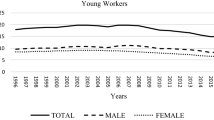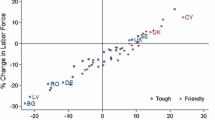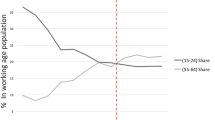Abstract
This study applies the time-varying parameter VAR and fully modified OLS cointegrating regression models to investigate the effect of demographic change on monetary policy effectiveness in Taiwan. Our results demonstrated that monetary policy effectiveness is negatively correlated with shares of total population in children (age < 15) and two older age groups (aged 55–64 and aged ≥ 65) but it is positively associated with shares of total population in primary working age groups (aged 15–54). These patterns of age distribution impacting on monetary policy effectiveness are highly consistent with the prediction from the life cycle hypothesis of saving and consumption. With an upward trend in ageing population but a downward trend in interest rate globally, policymakers should be cautious about the fact that monetary policy is mostly likely to be less effective in an ageing society. Policy promoting fertility (by providing strong incentives to have more children) or immigration (by attracting younger and more high-skilled laborers from population growing countries) should be listed as the top priority of economic and population policies in order to alleviate the negative impacts of rapid population ageing on the economy in the near future.



Similar content being viewed by others
References
Ajmi, A.N., Aye, G.C., Balcilar, M., Montasser, G.E., Gupta, R.: Causality between US economic policy and equity market uncertainties: evidence from linear and nonlinear tests. J. Appl. Econom. 18(2), 225–246 (2015)
Andersson, A., Österholm, P.: Forecasting real exchange rate trends using age structure data - the case of Sweden. Appl. Econom. Lett. 12, 267–272 (2005)
Andersson, A., Österholm, P.: Population age structure and real exchange rate in the OECD. Int. Econ. J. 20(1), 1–18 (2006)
Andrews, D.W.K.: Tests for parameter instability and structural change with unknown change point. Econometrica 61, 821–856 (1993)
Andrews, D.W.K., Ploberger, W.: Optimal tests when a nuisance parameter is present only under the alternative. Econometrica 61, 1383–1414 (1994)
Bae, Y.: Stock prices and demographic structure: a cointegration approach. Econ. Lett. 107, 341–344 (2010)
Berk, J., Weil, D.N.: Old teachers, old ideas, and the effect of population ageing on economic growth. Res. Econ. 69, 661–670 (2015)
Berlemann, M., Oestmann, M., Thum, M.: Demographic change and bank profitability: empirical evidence from German saving banks. Appl. Econ. 46(1), 79–94 (2014)
Bloom, D.E., Böersh-Supan, A., McGee, P., Seike, A.: Population ageing: facts, challenges, and responses. Program on the Global Demography, Harvard University. PGDA Working Paper No. 71 (2011)
Bloom, D.E., Canning, D.: Global demographic change: dimensions and economic significance. Pop. Dev. Rev. 34, 17–51 (2008)
Bloom, D.E., Canning, D., Fink, G.: Implications of population ageing for economic growth. Oxf. Rev. Econ. Policy 26(4), 583–612 (2010a)
Bloom, D.E., Canning, D., Hu, L., Liu, Y., Mahal, A., Yip, W.: The contribution of population health and demographic change to economic growth in China and India. J. Comp. Econ. 38, 17–33 (2010b)
Bloom, D.E., Canning, D., Malaney, P.N.: Population dynamics and economic growth in Asian. Pop. Dev. Rev. 26(supplement), 257–290 (2000)
Bloom, D.E., Chatterji, S., Kowal, P., Lloyd-Sherlock, P., McKee, M., Rechel, B., Rosenberg, L., Smith, J.P.: Macroeconomic implications of population ageing and selected policy responses. Lancet 385(9968), 649–657 (2015)
Bloom, D.E., Williamson, J.G.: Demographic transitions and economic miracles in emerging Asia. World Bank Econ. Rev. 12(3), 419–456 (1998)
Bullard, J., Garriga, C., Waller, C.: Demographics, redistribution, and optimal inflation. Fed. Reserve Bank St. Louis Rev. 94(6), 419–440 (2012)
Canon, M.E., Kudlyak, M., Reed, M.: Ageing and the economy: the Japanese experience. The Regional Economist, October, 2015 12–13 (2015)
Central Bank of Taiwan: Financial statistics monthly, Taipei: executive yuan, central bank of Republic of China (Taiwan), Taiwan (2016)
Elgin, C., Tumen, S.: Can sustained economic growth and declining population coexist? Barro-Becker children meet Lucas. Econ. Model. 29(5), 1899–1908 (2012)
Fair, R.C., Dominquez, K.M.: Effects of the changing U.S. age distribution on macroeconomic equations. Am. Econ. Rev. 81(5), 1276–1294 (1991)
Gajewski, P.: Is ageing deflationary? Some evidence from OECD countries. Appl. Econ. Lett. 22(11), 916–919 (2015)
Guest, R.: Population ageing and productivity: a survey with implications for New Zealand. N. Z. Econ. Pap. 48(2), 153–168 (2014)
Hansen, B.E.: Tests for parameters instability in regressions with I(1) processes. J. Bus. Econ. Stud. 10(3), 321–335 (1992)
Hansen, B.E.: Approximate asymptotic p values for structural-change tests. J. Bus. Econ. Stud. 15(1), 60–67 (1997)
Ikeda, D., Saito, M.: The effects of demographic changes on real interest rate in Japan. Japan World Econ. 32, 34–48 (2014)
Ilmakunnas, P., Ilmakunnas, S.: Work force ageing and expanding service sector: a double burden on productivity? Serv. Ind. J. 30, 2093–2110 (2010)
Imam, P.: Demographic shift and the financial sector stability: the case of Japan. J. Pop. Ageing 6, 269–303 (2013)
Imam, P.: Shock from graying: is the demographic shift weakening monetary policy effectiveness. Int. J. Financ Econ. 20, 138–154 (2015)
Kara, E., van Thadden, L.: Interest rate effects of demographic changes in a New-Keysian life-cycle framework. Macroecon. Dyn. 20(1), 120–164 (2016)
Lee, D., Park, C.: Real exchange rate dynamics and demographic structure in Korea. J. Econ. Theory Econom. 26(3), 1–14 (2015)
Li, X., Balcilar, M., Gupta, R., Chang, T.: The casual relationship between economic policy uncertainty and stock returns in China and India: evidence from a bootstrap rolling window approach. Emerg. Mark. Financ. Trade 52, 674–689 (2016)
Lucas, R.E.: Econometric policy evaluation: a critique. In: Brunne,r K., Meltzer, A. H. (eds.) The Phillips Curve and Labor Markets. Carnegie-Rochester Conference Series on Public Policy, vol. 1, pp. 19–46. North-Holland, Amsterdam (1976)
Mankiw, N.G., Weil, D.N.: The baby boom, the baby bust, and the housing market. Reg. Sci. Urban Econ. 19(2), 235–258 (1989)
Miles, D.: Should monetary policy be different in a greyer world? In: Auerbach, A.J., Herrmann, H. (eds.) Ageing, Financial Markets and Monetary Policy, pp. 243–276. Springer, Heidelberg (2002)
Ministry of Interior: Statistical Yearbook of Interior. Taipei: Executive Yuan, National Development Council, Taiwan (2015)
Modiglian, F., Brumberg, R.H.: Utility analysis and the consumption function: an interpretation of cross-section data. In: Kurihara, K.K. (ed.) Post-Keynesian Economics, pp. 388–436. Rutgers University Press, New Brunswick (1954)
Nagarajan, R., Teixeria, A.A.C., Silva, S.: The impact of population ageing on economic growth: an exploratory review of the main mechanisms. Faculdade de Economia da Universidade do Porto. FEP Working Paper No. 504 (2013)
Nagarajan, R., Teixeria, A.A.C., Silva, S.: The impact of population ageing on economic growth: an in-depth bibliometric analysis. Singap. Econ. Rev. (2015). doi:10.1142/S021759081550068X
Nakajima, J.: Time-varying parameter VAR model with stochastic volatility: an overview of methodology and empirical applications. Monet. Econ. Stud. 29, 107–142 (2011)
National Development Council: Population projections for R.O.C. (Taiwan) 2014–2060. Taipei: Executive Yuan, National Development Council, Taiwan (2015)
National Institute on Ageing: Why population aging matters: a global perspective. National Institute on Ageing and National Institute of Health. Booklet Publication No. 07-6134 (2007)
Neuberger, D., Räthke-Döppner, S.: The role of demographics in small business loan pricing. Small Bus. Econ. 44(2), 411–424 (2015)
Park, C.: How does changing age distribution impact stock prices? A nonparametric approach. J. Appl. Econom. 25, 1155–1178 (2010)
Park, C., Kim, D.H.: Demographic structure and financial markets in Korea. Korea World Econ. 13(2), 307–328 (2012)
Park, D., Rhee, C.: Population and financial markets: a cross-country study. Seoul J. Econ. 20(31), 333–354 (2007)
Phillips, P.C., Hansen, B.E.: Statistical inference in instrumental variables regression with I(1) process. Rev. Econ. Stud. 57, 99–125 (1990)
Quayes, S., Jamal, A.M.M.: Impact of demographic change on stock prices. Q. Rev. Econ. Financ. (2015). doi:10.1016/j.qref.2015.08.005
Rose, A.K., Supaat, S., Braude, J.: Fertility and the real exchange rate. Can. J. Econ. 42(2), 496–518 (2009)
Saita, Y., Shimizu, C., Watanabe, T.: Aging and real estate prices: evidence from Japanese and US regional data. Int. J. Hous. Mark. Anal. 9(1), 66–87 (2016)
Šević, A., Brawn, D.: Do demographic changes matter? A cross-country perspective. J. Multinatl. Financ. Manag. 30, 36–61 (2015)
Shappe, A.: Is ageing a drag on productivity growth? a review article on ageing, health and productivity: the economics of increased life expectancy. Int. Product. Monit. 21, 82–94 (2011)
Takáts, E.: Aging and house prices. J. Hous. Econ. 21(2), 131–141 (2012)
United Nations: World population prospects: The 2015 revision, key findings and advance tables. Department of Economic and Social Affairs, Population Division. Working Paper No. ESA/P/WP.241 (2015)
van der Gaag, N., de Beer, J.: From demographic dividend to demographic burden: the impact of population ageing on economic growth in Europe. Tijdschrift voor economische en sociale geografie 106(1), 94–109 (2015)
Vogel, E.F.: The four little dragons: the spread of industrialization in east Asia. Harvard University Press, Boston (1993)
Yoon, J.W., Kim, J., Lee, J.: Impact of demographic changes on inflation and the macroeconomy. International Monetary Fund, IMF Working Paper No. 2014/210 (2014)
Authors’ contributions
I designed the study, analyzed the data and wrote the manuscript.
Author information
Authors and Affiliations
Corresponding author
Ethics declarations
Conflict of interest
I have no relevant affiliations or financial involvement with any organization or entity with a financial interest or financial conflict with the subject matter or materials discussed in the manuscript. This includes employment, consultancies, honoraria, stock ownership or options, expert testimony, grants or patents received or pending, or royalties.
Appendix: Time plots for variables used in this study
Appendix: Time plots for variables used in this study
See Fig. 4.
Time plots for variables used in this study. Time plots for accumulative and maximum responses of inflation and unemployment rates to 1 SE change of interest rate are displayed in Fig. 2. a Interest rate gap. b Unemployment rate gap. c Inflation rate. d Openness. e Linear transformation for age distribution. f Quadratic transformation for age distribution
Rights and permissions
About this article
Cite this article
Chen, WY. Demographic structure and monetary policy effectiveness: evidence from Taiwan. Qual Quant 51, 2521–2544 (2017). https://doi.org/10.1007/s11135-016-0407-1
Published:
Issue Date:
DOI: https://doi.org/10.1007/s11135-016-0407-1
Keywords
- Demographic change
- Monetary policy
- Population ageing
- Time-varying parameter VAR model
- Fully modified OLS model
- Taiwan





